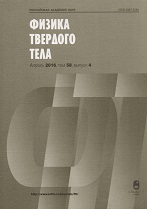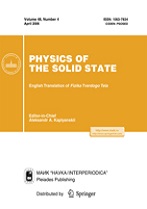|
This article is cited in 7 scientific papers (total in 7 papers)
Phase transitions
Kinetics of the phase transition in crystals PbIn$_{1/2}$Nb$_{1/2}$O$_{3}$–PbMg$_{1/3}$Nb$_{2/3}$O$_{3}$–$x$PbTiO$_{3}$
L. S. Kamzina, L. A. Kulakova
Ioffe Institute, St. Petersburg
Abstract:
The time dependences of the optical transmission, velocity of sound, and elastic constants at room temperature in a number of the [001]-oriented PbIn$_{1/2}$Nb$_{1/2}$O$_{3}$–PbMg$_{1/3}$Nb$_{2/3}$O$_{3}$–$x$PbTiO$_{3}$ single crystals with the compositions lying both far from the morphotropic phase boundary and in its vicinity have been investigated. The analysis of the data obtained has been carried out. It has been shown that, in all the studied crystals, phase transitions induced by an electric field occur in two stages: the first stage is an incubation period associated with a small increase in the polarization of a part of the sample being in the glass phase, and the second phase (after the incubation period $\tau$) is a rapid increase in the polarization and the formation of a long-range order. It has been found that the time $\tau$ depends on how close is the temperature of measurements to the Vogel–Fulcher temperature $T_ f$. The closer is the temperature of measurements to the Vogel–Fulcher temperature $T_f$, the weaker is the electric field required to be applied to the sample in order to induce a ferroelectric phase. It has been demonstrated that the phase state of the studied crystals is unstable, which manifests itself in a strong dependence of the incubation period $\tau$ on the time between the annealing of the sample and the beginning of the measurements. The stability of the phase state depends on the PbTiO$_{3}$ concentration: an increase in the concentration leads to a significant increase in the stability.
Keywords:
Electric Field Strength, Optical Transmission, Ferroelectric Phase, Glass Phase, Morphotropic Phase Boundary.
Received: 23.06.2015
Citation:
L. S. Kamzina, L. A. Kulakova, “Kinetics of the phase transition in crystals PbIn$_{1/2}$Nb$_{1/2}$O$_{3}$–PbMg$_{1/3}$Nb$_{2/3}$O$_{3}$–$x$PbTiO$_{3}$”, Fizika Tverdogo Tela, 58:1 (2016), 176–181; Phys. Solid State, 58:1 (2016), 183–189
Linking options:
https://www.mathnet.ru/eng/ftt10127 https://www.mathnet.ru/eng/ftt/v58/i1/p176
|


| Statistics & downloads: |
| Abstract page: | 45 | | Full-text PDF : | 32 |
|





 Contact us:
Contact us: Terms of Use
Terms of Use
 Registration to the website
Registration to the website Logotypes
Logotypes









 Citation in format
Citation in format 
